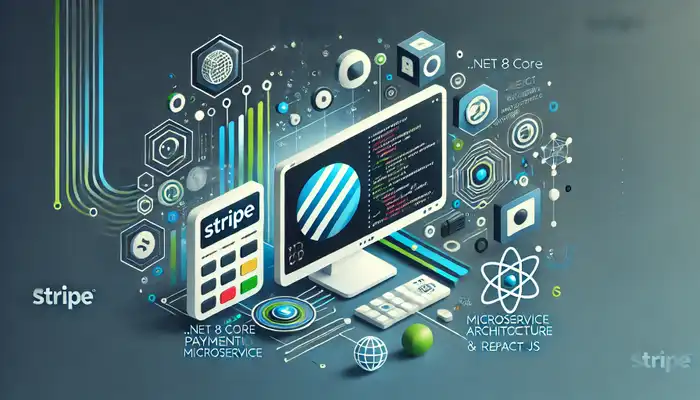Stripe Payment using .NET 8 Core Microservice and React JS
In this blog, we will walk through the process of integrating Stripe payments into a .NET 8 Core Microservice architecture with a React JS front-end. This will cover both the backend API for processing payments and the React component for capturing customer details and initiating payments.
Prerequisites
- Stripe Account: Sign up for a Stripe account.
- Stripe API Keys: Get your publishable and secret keys from the Stripe Dashboard.
- .NET 8 SDK: Ensure you have the latest version of the .NET 8 SDK installed.
- React JS: Basic knowledge of React JS and how to set up a React application.
Setting Up the .NET 8 Core Microservice
1. Create a New .NET 8 API Project
dotnet new webapi -n StripePaymentService
cd StripePaymentService2. Install Stripe SDK
Add the Stripe NuGet package to your project:
dotnet add package Stripe.net --version 42.0.03. Configure Stripe in appsettings.json
In the appsettings.json file, add your Stripe secret key.
{
"Stripe": {
"SecretKey": "your-stripe-secret-key",
"PublishableKey": "your-stripe-publishable-key"
}
}4. Setup Stripe Service in .NET 8 Core
In the Program.cs file, configure Stripe services:
var builder = WebApplication.CreateBuilder(args);
// Add services to the container.
builder.Services.Configure<StripeSettings>(builder.Configuration.GetSection("Stripe"));
builder.Services.AddSingleton<IStripeClient, StripeClient>(sp =>
{
var config = sp.GetRequiredService<IOptions<StripeSettings>>().Value;
return new StripeClient(config.SecretKey);
});
builder.Services.AddControllers();
var app = builder.Build();
app.UseHttpsRedirection();
app.UseAuthorization();
app.MapControllers();
app.Run();5. Create a Stripe Payment Controller
Create a new controller named PaymentController.cs to handle the payment request.
[ApiController]
[Route("api/[controller]")]
public class PaymentController : ControllerBase
{
private readonly IStripeClient _stripeClient;
public PaymentController(IStripeClient stripeClient)
{
_stripeClient = stripeClient;
}
[HttpPost("create-payment-intent")]
public async Task<IActionResult> CreatePaymentIntent([FromBody] PaymentIntentRequest request)
{
var options = new PaymentIntentCreateOptions
{
Amount = request.Amount,
Currency = request.Currency,
PaymentMethodTypes = new List<string> { "card" }
};
var service = new PaymentIntentService(_stripeClient);
var paymentIntent = await service.CreateAsync(options);
return Ok(new { clientSecret = paymentIntent.ClientSecret });
}
}
public class PaymentIntentRequest
{
public long Amount { get; set; }
public string Currency { get; set; }
}6. Test the API
You can test the API using Postman or another API testing tool. Send a POST request to https://localhost:5001/api/payment/create-payment-intent with the following JSON payload:
{
"amount": 2000,
"currency": "usd"
}If successful, it will return a clientSecret which you will use in the front-end to complete the payment.
React JS Frontend Integration
1. Install Stripe React and Stripe.js
In your React project, install the necessary Stripe packages:
npm install @stripe/react-stripe-js @stripe/stripe-js2. Configure Stripe in React
Set up the StripeProvider and Elements in your App.js:
import React from 'react';
import { Elements } from '@stripe/react-stripe-js';
import { loadStripe } from '@stripe/stripe-js';
import PaymentForm from './PaymentForm';
const stripePromise = loadStripe('your-publishable-key');
function App() {
return (
<Elements stripe={stripePromise}>
<PaymentForm />
</Elements>
);
}
export default App;3. Create Payment Form Component
Create a new component PaymentForm.js that will handle the payment process:
import React, { useState } from 'react';
import { CardElement, useStripe, useElements } from '@stripe/react-stripe-js';
const PaymentForm = () => {
const [amount, setAmount] = useState(2000); // Amount in cents
const stripe = useStripe();
const elements = useElements();
const handleSubmit = async (event) => {
event.preventDefault();
const { error, paymentIntent } = await createPaymentIntent(amount);
if (!error && stripe && elements) {
const { error: stripeError } = await stripe.confirmCardPayment(paymentIntent.clientSecret, {
payment_method: {
card: elements.getElement(CardElement)
}
});
if (stripeError) {
console.error('Payment failed', stripeError);
} else {
console.log('Payment successful');
}
}
};
const createPaymentIntent = async (amount) => {
const response = await fetch('https://localhost:5001/api/payment/create-payment-intent', {
method: 'POST',
headers: { 'Content-Type': 'application/json' },
body: JSON.stringify({ amount, currency: 'usd' })
});
return await response.json();
};
return (
<form onSubmit={handleSubmit}>
<CardElement />
<button type="submit" disabled={!stripe}>Pay</button>
</form>
);
};
export default PaymentForm;4. Test the Frontend
Run your React application and test the payment flow by entering card details such as:
- Card Number:
4242 4242 4242 4242 - Expiration Date: Any future date
- CVC: Any 3-digit number
If everything is configured correctly, you should see a successful payment response in your browser.
Conclusion
Integrating Stripe payments with a .NET 8 Core Microservice and React JS is a powerful way to handle secure transactions. The combination of .NET for backend processing and React for handling frontend interactions ensures a smooth and efficient payment experience.
This blog demonstrated setting up a microservice, processing payments with Stripe, and building a frontend interface for users. Happy coding!
Praful's Newsletter 🚀
Join 3900+ Engineers to Level Up Your Skills!
Subscribe to my Software Engineering Deep Dive Series covering ReactJS, Redux, ASP.NET Core, and Clean Architecture. Get 1 insightful email each week to enhance your development journey.
